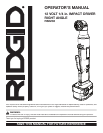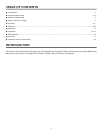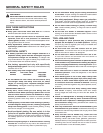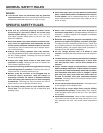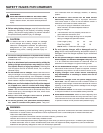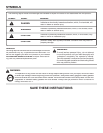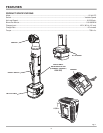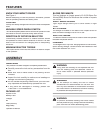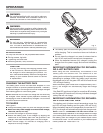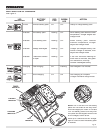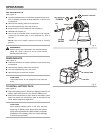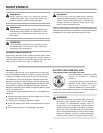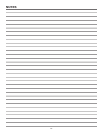
4
SERVICE
n
Tool service must be performed only by qualified
repair personnel.
Service or maintenance performed by
unqualified personnel may result in a risk of injury.
GENERAL SAFETY RULES
n
When servicing a tool, use only identical replacement
parts. Follow instructions in the Maintenance section
of this manual.
Use of unauthorized parts or failure to
follow Maintenance Instructions may create a risk of
shock or injury.
SPECIFIC SAFETY RULES
n
Hold tool by insulated gripping surfaces when
performing an operation where the screw may
contact hidden wiring.
Contact with a “live” wire will
also make exposed metal parts of the tool “live” and
shock the operator.
n
Know your power tool. Read operator’s manual care-
fully. Learn its applications and limitations, as well
as the specific potential hazards related to this tool.
Following this rule will reduce the risk of electric shock,
fire, or serious injury.
n
Always wear safety glasses with side shields.
Everyday glasses have only impact resistant lenses. They
are NOT safety glasses. Following this rule will reduce
the risk of eye injury.
n
Protect your lungs. Wear a face or dust mask if the
operation is dusty.
Following this rule will reduce the
risk of serious personal injury.
n
Protect your hearing. Wear hearing protection during
extended periods of operation.
Following this rule will
reduce the risk of serious personal injury.
n
Battery tools do not have to be plugged into an
electrical outlet; therefore, they are always in
operating condition. Be aware of possible hazards
when not using your battery tool or when changing
accessories.
Following this rule will reduce the risk of
electric shock, fire, or serious personal injury.
n
Do not place battery tools or their batteries near
fire or heat.
This will reduce the risk of explosion and
possibly injury.
n
Never use a battery that has been dropped or
received a sharp blow.
A damaged battery is subject to
explosion. Properly dispose of a dropped or damaged
battery immediately.
n
Batteries vent hydrogen gas and can explode in the
presence of a source of ignition, such as a pilot light.
To reduce the risk of serious personal injury, never use
any cordless product in the presence of open flame. An
exploded battery can propel debris and chemicals. If
exposed, flush with water immediately.
n
Do not charge battery tool in a damp or wet
location.
Following this rule will reduce the risk of electric
shock.
n
For best results, your battery tool should be charged
in a location where the temperature is more than
50°F but less than 100°F. Do not store outside or in
vehicles.
n
Under extreme usage or temperature conditions,
battery leakage may occur. If liquid comes in contact
with your skin, wash immediately with soap and water,
then neutralize with lemon juice or vinegar. If liquid
gets into your eyes, flush them with clean water for
at least 10 minutes, then seek immediate medical
attention.
Following this rule will reduce the risk of seri-
ous personal injury.
n
Do not use the impact driver as a drill.
The impact driver
is not designed to be used as a drill.
n
Do not drive a screw where there may be hidden
wiring behind the surface.
Contact with a “live” wire will
make exposed metal parts of the tool “live” and shock
the operator.
n
Save these instructions.
Refer to them frequently and
use them to instruct others who may use this tool. If you
loan someone this tool, loan them these instructions
also.



